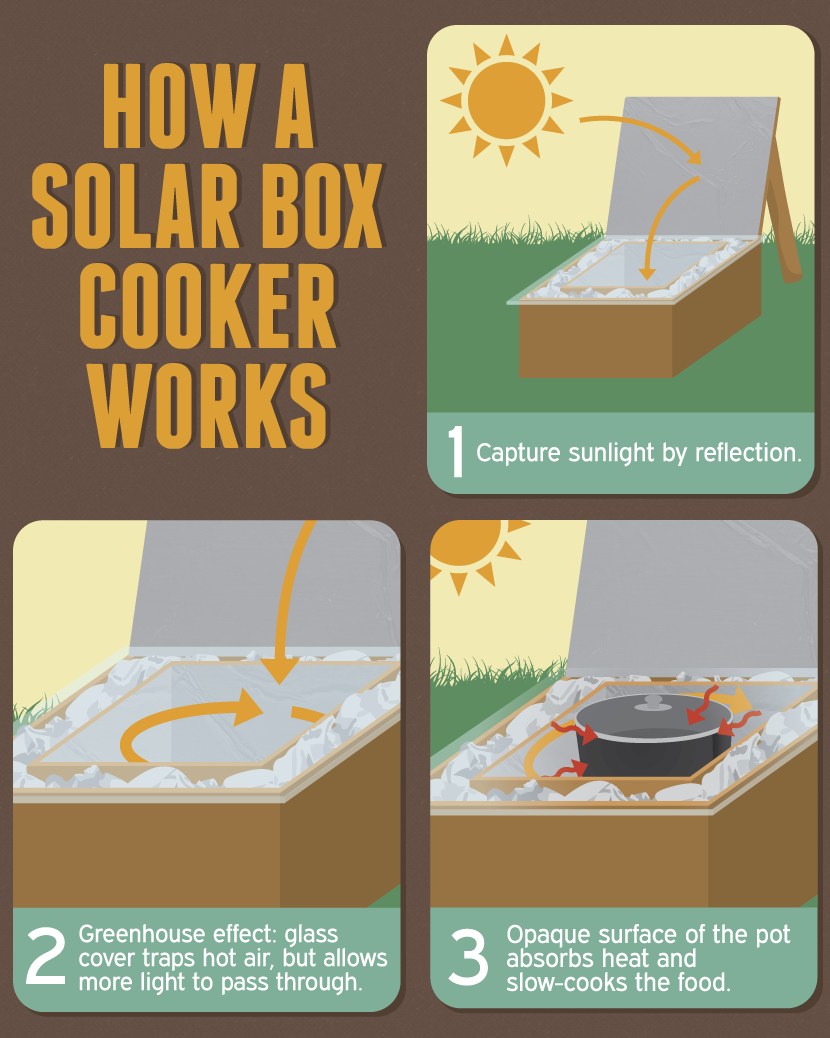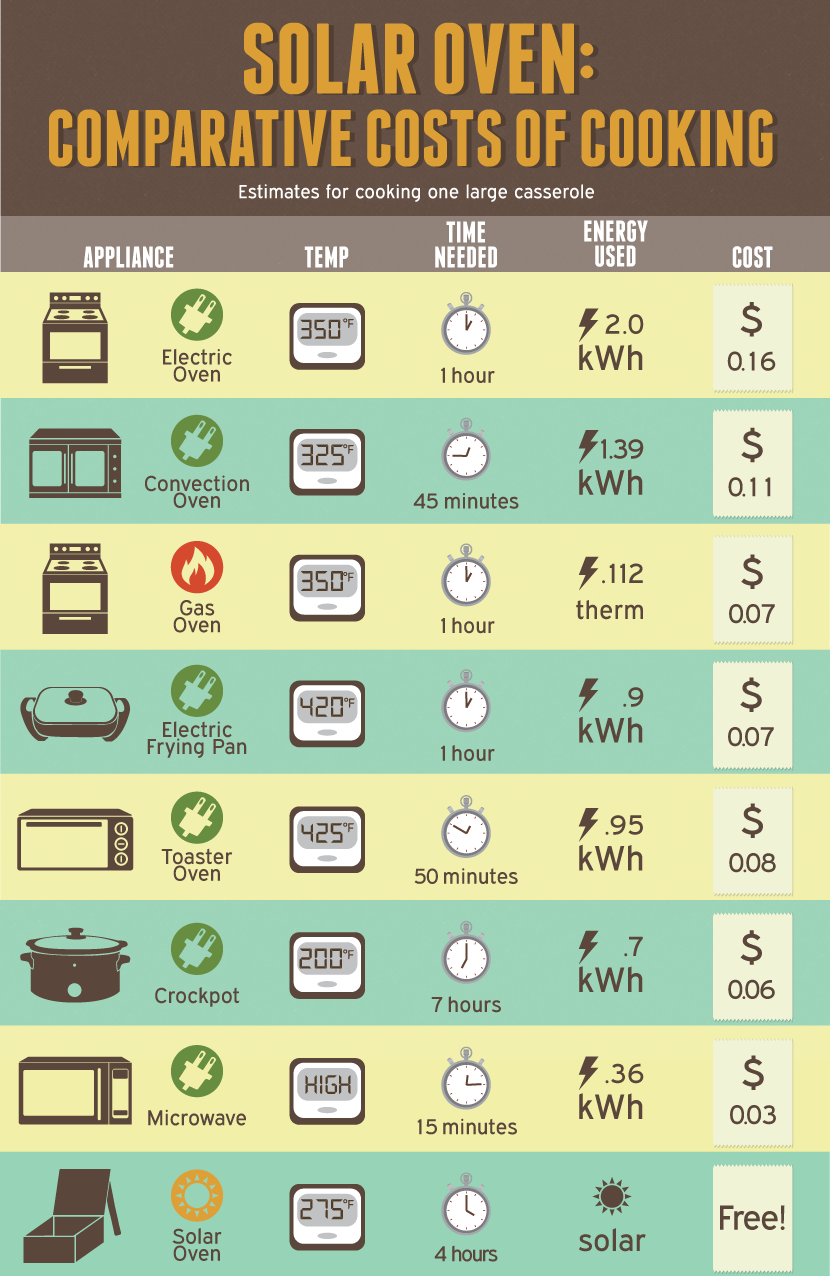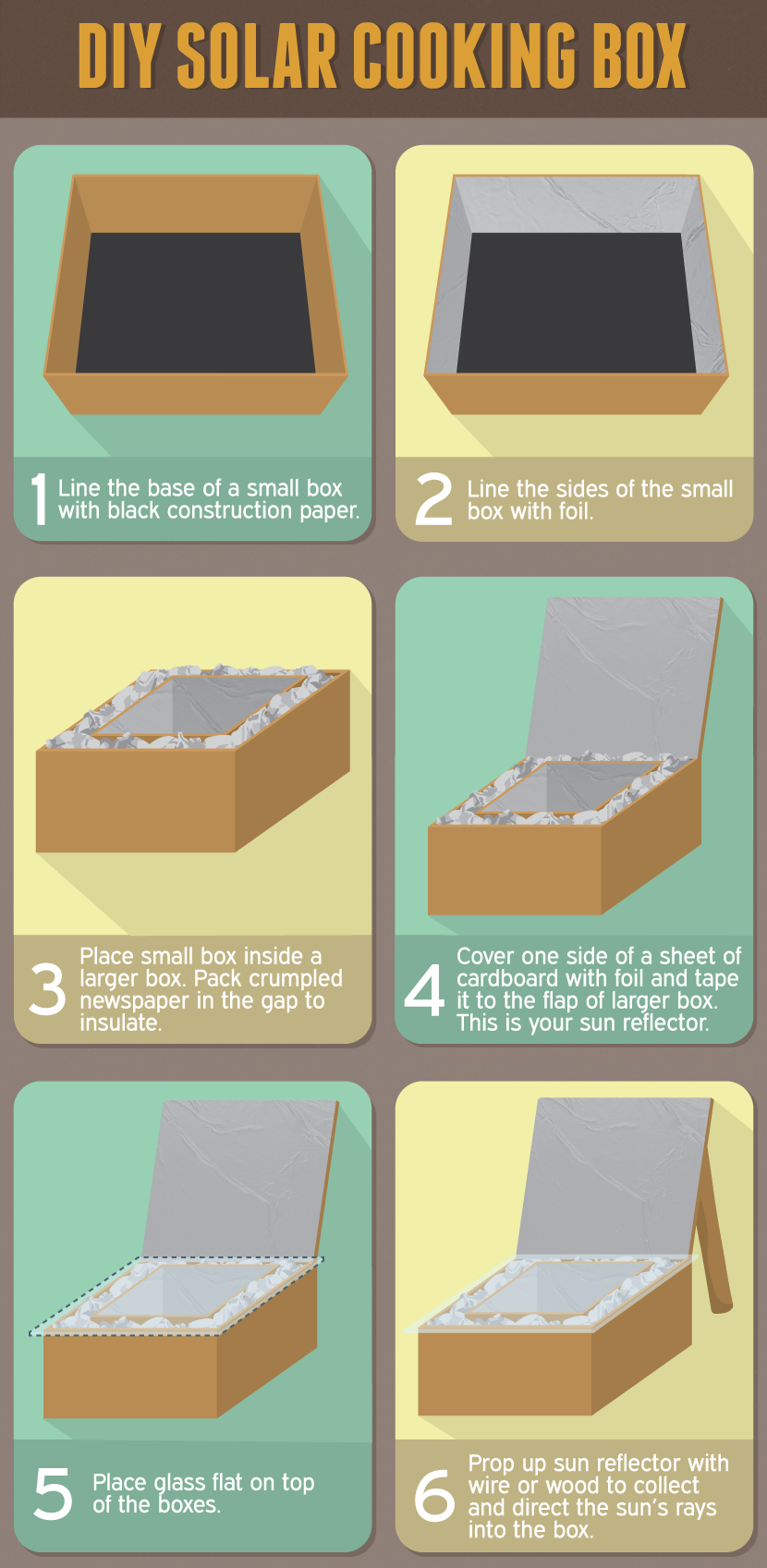Make Food While the Sun Shines
Constructing and Utilizing a DIY Solar Cooker
If you’ve ever stepped barefoot onto blacktop on a sweltering summer day, you’re probably already painfully familiar with the extraordinary heating power of the sun. Harnessing this free energy is the crux of solar cooking – a fast, renewable, pollution-free method of food preparation. Solar cooking has long been on the agenda of ideal sustainable living practices, but with new innovations and dwindling natural resources, there’s hope to have a fully powered solar eating future ahead.
Cooking Greenhouse Style
Traditional solar cooking uses reflectors to capture the sun’s rays. This light is directed to a focal point, which is typically a solar cooking box, that then traps and converts the sunlight into heat energy. This reflection of light into a box is like a miniature version of the greenhouse effect that warms the earth’s atmosphere.

Solar heat is free, emissions-free, and available year-round regardless of air temperature. When harnessed properly, the thermal energy of the sun’s rays can cook nearly anything that an oven or stovetop range can. The biggest difference is that there’s no cost to you or to the environment.
How Much Energy Does Cooking Your Meal Require?
If you are the average American, a moderate percentage of your electric or gas bill is going toward heating your food. Appliance use accounts for 13 percent of household energy costs, with refrigeration, cooking, and laundry at the top of the list. If you live in of the 80 percent of households that own a grill, you are likely spending an additional $5 to $20 per month depending upon method used (charcoal or gas grilling).

The cost of solar cooking is minimal. A basic solar cooking box can be handmade for around $5 to $25. Manufactured units range from $25 to upward of $500 depending upon the complexity and materials used.
Getting Started by Building a Solar Cooking Box
It’s an easy, low-cost proposition to try out solar cooking to see whether it’s a practice you’re comfortable adding to your culinary repertoire. A simple solar cooking box takes less than an hour to construct using these readily available materials:
• Two cardboard boxes (12 x 12 x 12 or larger). One box should be bigger than the other, with a 1½-inch gap between the boxes for insulating.
• Sheet of cardboard
• Aluminum foil or Mylar bubble wrap
• Newspaper
• Foil tape or duct tape
• Black construction paper
• Non-toxic glue
• Glass (sized to fit, slightly overlapping the top of the larger cardboard box opening)
• Scissors
You can find tons of free videos on the Internet with simple construction designs to create various styles. To get started making a basic cooker, follow the diagram and steps below.

The idea here is to place one box inside the other, which creates an insulated chamber. First, cut the flaps from the boxes, leaving one flap intact from the larger (outer) box to use as a hinge. Fully cover the inside bottom of the inner (smaller) box with black construction paper and glue in place. Cover the sides of the inner box with foil (or Mylar bubble wrap) and glue in place. Cut the cardboard sheet the same size as the opening of the outer (larger) box. Cover one side of the sheet of cardboard with foil (or Mylar bubble wrap) and glue in place.
Next, seal the edges of the inner box and cardboard with foil tape (or duct tape). Crumple newspaper and use it to line the bottom of the outer box. This is your insulation for the cooker. Make sure that enough newspaper is used to lift the inner box so that the edges are level with the outer box when placed inside. Place the inner (smaller) box inside the outer (larger) box. Pack in crumpled newspaper on all sides to insulate. The inner box should now fit snugly inside the outer box. Tape the foil-covered cardboard sheet to the remaining flap of the outer (larger box), with the foil side facing the inside of the box. This is your sun reflector. Place glass on top of the opening of the solar cooker. Position the solar reflector to collect and direct the sun’s rays into the box. Tip: use a sturdy piece of wire or wood to help keep reflector propped in the ideal position.
Cooking With Your Solar Oven
To cook, simply lift the glass lid of the solar cooker and place the pan or pot with food inside the box and place the glass lid back on. Position the solar reflector to collect the sun’s rays and heat. Cooking times and temperatures will vary in homemade solar cookers. The average box cooker will reach temperatures around 250 to 300 degrees Fahrenheit. You can test the temperature of your solar cooking box using a standard oven thermometer.
With very little to lose and plenty of free eco-friendly energy to gain, it’s easy to see why solar cooking is an ideal method to utilize. This form of cooking is not only great for preparing a nice, warm meal but also ideal for pasteurizing water. In times of “boil water” advisories or in areas where lack of clean water is an issue, solar cooking methods can be life-saving.
There are some drawbacks to solar cooking, though, that should be taken into consideration when determining whether solar cooking is going to be beneficial for you:
Reliance on sunshine. To harness the benefits of solar cooking, you must have access to the sun. Solar cookers are ineffective on overcast days and at night. Rainy days can also put a huge damper on solar cooking efforts.
Restrictive cooking times. You will have to plan your solar cooking to maximize daylight hours. If you need four hours to cook your meal, you will not be able to begin the process two hours prior to sunset. For people who work outside the home or those who do not have time to monitor the solar cooking process, solar cooking may not be a feasible option.
Inefficiency of heat retention. Solar cooking in winter in cold-weather climates can be difficult, as the unit will lose its warmth easily. Unlike conventional ovens, solar cookers typically do not have the ability to retain heat in extreme weather conditions or when the sunshine is sporadic.
On the upside, the drawbacks are also what contribute to solar cooked meals having excellent taste and less chance of over-cooking. Because it is a slow cooking method, solar cooking can mean that meals are often rich in flavor, more nutrients are preserved, and it’s difficult to burn food.
Is Solar Cooking for Me?
Still not sure whether solar cooking is for you? Test out the method for a few of your summer meals or use a solar cooker for your next camping trip to conserve fuel while helping to reduce emissions and improve the air quality in your environment.
Solar cooking is a fast, portable, versatile, fuel-free, renewable, clean, and non-polluting energy alternative. The bottom line is that, with the low monetary investment and ease of utilizing solar cooking methods, it’s a worthwhile culinary venture to utilize!
Embed the article on your site

